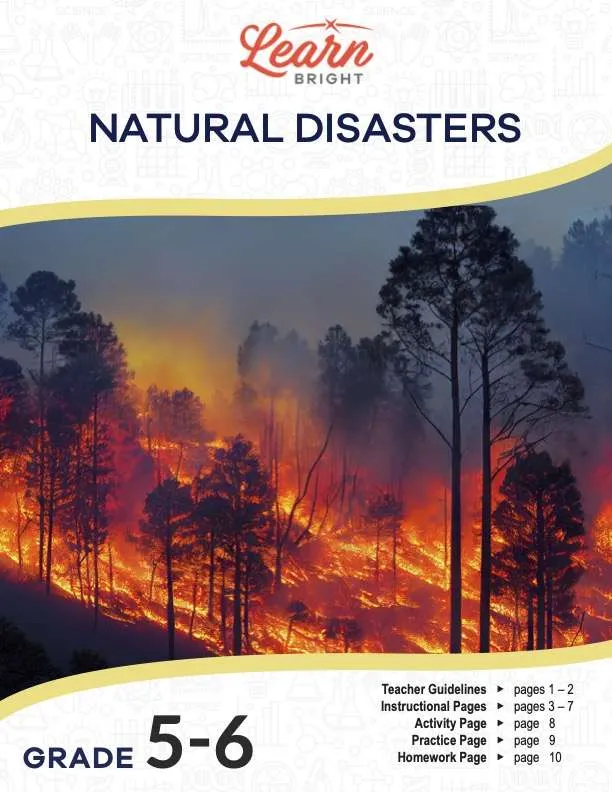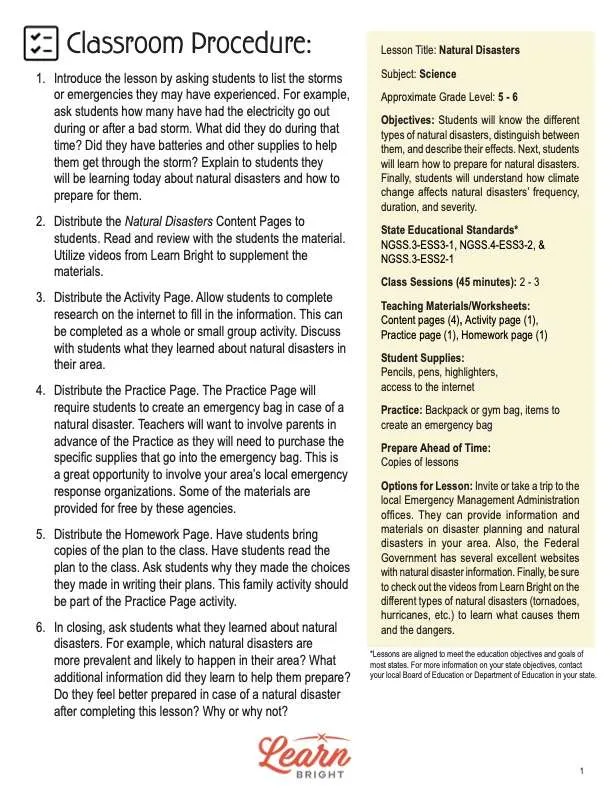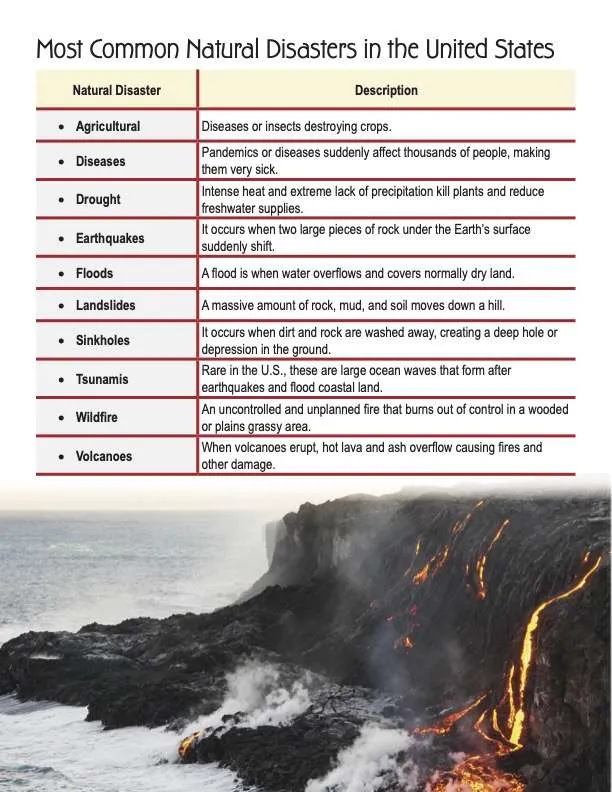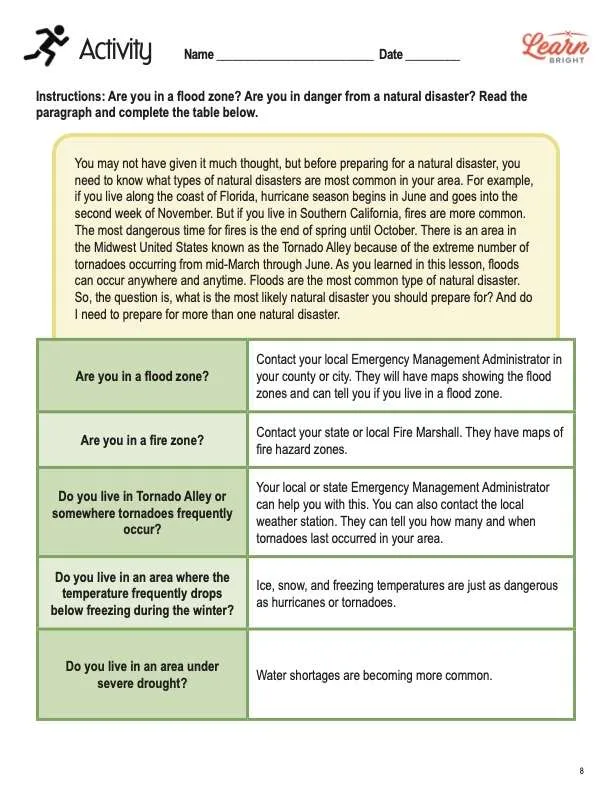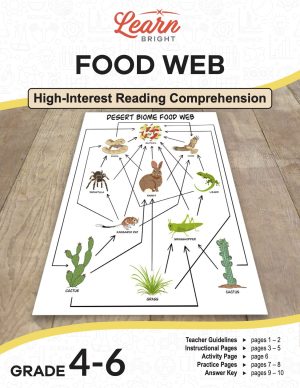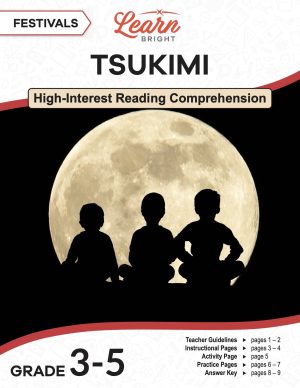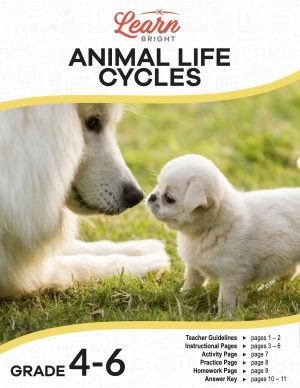Description
What our Natural Disasters lesson plan includes
Lesson Objectives and Overview: Natural Disasters teaches students about several types of common dangerous storms. Students will learn what causes these storms and what their effects are. By the end of the lesson, they will be able to identify each type and list their traits. This lesson is for students in 4th grade, 5th grade, and 6th grade.
Classroom Procedure
Every lesson plan provides you with a classroom procedure page that outlines a step-by-step guide to follow. You do not have to follow the guide exactly. The guide helps you organize the lesson and details when to hand out worksheets. It also lists information in the yellow box that you might find useful. You will find the lesson objectives, state standards, and number of class sessions the lesson should take to complete in this area. In addition, it describes the supplies you will need as well as what and how you need to prepare beforehand. For this lesson, make sure you have writing paper and access to some kind of word processing software. You will also need access to the internet.
Options for Lesson
This lesson contains quite a few suggestions in the “Options for Lesson” section that you can take advantage of for your students. One idea is to assign students a single natural disaster to write about for their story or diary for the activity. They can expound on the details of that one storm rather than writing about all 10 of them. Students can then read their stories to the class. You could also collect all the students’ stories and create a booklet. Another suggestion is to divide students into groups and have each one create a skit that relates to one of the natural disasters. If any students have parents who have experienced one of these storms, you could also invite them to the class to talk about what happened.
Teacher Notes
The paragraph on the teacher notes page provides a few extra guidelines to consider while planning the lesson. You will definitely want to ensure you are sensitive to students’ feelings if any have been affected by a natural disaster in some way. You should stress that these events happen throughout the world and that students do not need to live in fear of them if they prepare. The lesson does not describe ways to prepare for each one, but you could do your own research and provide it as supplemental material. You can also use the blank lines on this page to write down any other ideas or thoughts you have for the lesson.
NATURAL DISASTERS LESSON PLAN CONTENT PAGES
Introduction
The Natural Disasters lesson plan contains five pages of content. Students will learn that while disasters can include any number of events, natural disasters are very specific. These catastrophes can only happen by natural processes. Such events occur in populated areas of the world and often cause loss of life, property damage, and economic issues.
Included in this list are tornados, hurricanes, droughts, landslides, blizzards, and hail storms. The interesting thing about these events is that we don’t consider them disasters if they don’t cause damage or loss of life. If a tsunami washes over an unpopulated island, we don’t consider it a natural disaster. To be a disaster, it must cause loss or damage of some kind.
Students will then learn that it is entirely possible for more than one natural disaster to occur at the same time. They happen all over the world, and people can sometimes prepare for them. Other times, however, there is no warning. The lesson also explains that some places are more prone to certain types of storms than others. For instance, if someone lives in the middle of the United States, they don’t need to worry about tsunamis, which would only occur along the coasts. However, they might have to prepare for tornados, which happen far more often in that region than on the coasts.
Types of Natural Disasters
The lesson introduces several types of storms, including the following. These are 10 of the most common types that happen throughout the world. Students will also discover how important it is to understand these storms even if they don’t live in a place where they happen often. It is always important to respect and be sensitive to those who have been through such experiences either directly or indirectly.
Blizzard, Drought, Earthquake, Flood, Heat Wave
Blizzard: These are extremely intense snowstorms with winds that reach up to 35 miles an hour. During a blizzard, it is very difficult to see, making it incredibly dangerous to travel.
Drought: One of the worst natural disasters, droughts happen when there is no rainfall for a long period of time. Human activities like deforestation can also cause droughts. Effects include water shortages, dust bowls and storms, famines, hunger, malnutrition, starvation, and wildfires.
Earthquake: These sudden and violent movements of the earth can be minor, but major earthquakes can topple buildings and bridges. They can cause a lot of property damage and loss of life. They can also cause other disasters, such as tsunamis, fires, avalanches, and floods.
Flood: Floods occur when heavy rain, melting ice and snow, or overflowing bodies of water cover the land where water should not be. These can cause tremendous property damage, sometimes destroying homes or cars completely. They can also contaminate water supplies and destroy farmlands.
Heat wave: A heat wave involves temperatures that are much higher than normal. High pressure in the atmosphere builds up, holding in hot air on the surface of the earth. As a result, it’s less likely to rain. Heat waves often affect people’s health and cause heat exhaustion and other illnesses. They can also cause roads to buckle and plants to die.
Hurricane, Thunderstorm, Tornado, Tsunami, Wildfire
Hurricane: With wind speeds up to 160 miles per hour, these giant swirling water storms can cause a great amount of damage. Hurricanes, or typhoons, occur at specific times of the year, which is helpful in regards to preparation.
Thunderstorm: These storms include lightning, high winds, and usually heavy rain. They can also send hail, sleet, and snow to the earth’s surface. They occur when there is a surge of moist, warm air. They can even turn into tornados.
Tornado: Another of the most dangerous and destructive natural disasters, tornados have wind speeds from 100 to 300 miles per hour. They occur over land and sea. The destructive column of rotating air can come in many shapes and sizes, but they always appear as some kind of funnel.
Tsunami: These giant water waves that surge onto land reach heights of up to 100 feet. They usually happen in oceans but can also occur on lakes. Underwater quakes cause tsunamis.
Wildfire: These major fires mostly happen because of human error, but sometimes happen naturally. They are dangerous and unpredictable and often spread very easily, causing major damage to forests and animal habitats.
Other natural disasters include landslides, avalanches, and volcanoes. The lesson provides some information on these events as well. Students will learn which of these events are predictable and which are not.
How to Prepare for a Natural Disaster
Meteorologists, or people who study and predict the weather, know
when the weather conditions are right for thunderstorms. However, one result of violent thunderstorms is a tornado. There is no accurate way to predict if, when, or where a tornado will touch down. Thunderstorm lightning can cause wildfires and knock out power even if no tornado exists.
The winds can blow down trees and rip rooftops from houses. The hard rain causes flooding, which creates landslides and sinkholes. Thunderstorms can produce large hail stones that pound on the ground and anything else in the area. Even in storms that don’t seem as dangerous as a hurricane, there is still a lot of potential damage. All natural disasters are harmful and destructive. And while we can’t always predict them, we can prepare.
Regardless of the potential disaster, we need to have a plan. For example, if the electricity goes off, what do we need to ensure we an see and remain warm? Do we have enough water and food to last for a few days?Next, we need to prepare. Flashlights, batteries, matches, and bottled water are all necessities. How much we need depends on how long we think the disaster will last. For example, people who suffer from hurricanes sometimes go ten or more days without electricity and running water.
Finally, we need to practice. If we are in school, we practice fire drills. Similarly, we should practice going through the plans we made so that everyone knows what to do, where to go, and how to contact other family members.
Natural Disasters and Climate Change
For several decades, scientists have been monitoring the weather. Remember, the scientific definition for weather is “the state of the atmosphere, including temperature, atmospheric pressure, wind, humidity, precipitation, and cloud cover.” So how we think about weather is how cold or hot, wet or dry, and sunny or cloudy it is outside daily.
Climate is the “long-term pattern of weather in a particular area. Weather can change from hour-to-hour, day-to-day, month-to-month, or even year-to-year.” Climate change is the long-term change in weather patterns and climate. Scientists have noted an alarming trend in studying climate—the earth is warming.
Over thousands of years, the climate has gone through many changes, from colder to warmer or the opposite. However, in the last 200 years, the earth has gotten much warmer much faster. What does this have to do with natural disasters? Well, weather is caused by heat generated by the sun and air movement. Therefore, the weather doesn’t stay the same in the same place. For example, millions of years ago, what is now the Sahara Desert teemed with plant life. Now it is a dry, arid desert. Because the earth is rapidly warming and heat is trapped in our atmosphere by carbon dioxide gases, the heat in the atmosphere has devastating effects on the surface.
Increased natural disasters such as hurricanes, tornadoes, violent thunderstorms, and winter blizzards may result from climate change. Scientists believe there are more natural disasters today than a few short centuries ago due to global warming. As a result, natural disasters will be more common, intense, and devastating to life today and in the future. Therefore, you must be prepared in the future for more and more intense natural disasters.
NATURAL DISASTERS LESSON PLAN WORKSHEETS
The Natural Disasters lesson plan includes three worksheets. Each one will help students solidify their grasp of the concepts in different ways. You can look at the classroom procedure guidelines to know when to hand them out.
FLOOD ZONE PREP ACTIVITY WORKSHEET
For the activity, students will read the paragraph about natural disasters at the top of the worksheet. A table below shows five questions about the area in which the students live. In the right column, they will explain what they would do if they were to answer yes to these questions.
CHECKLIST PRACTICE WORKSHEET
The practice worksheet continues on from the activity. Students will use the information they provided in the activity to create an emergency bag. They will gather various items according to what they would need. Such items will be based on where the students actually live and the natural disasters common to the area.
NATURAL DISASTERS HOMEWORK ASSIGNMENT
Students will again reference the previous two worksheets to develop a disaster plan. They will first fill out the chart at the top of the page. Then they will write in the information on the paragraph at the bottom.
Worksheet Answer Keys
There is an answer key for the activity page that provides sample responses for the assignment. You could choose to show these answers to help guide students’ work if you prefer. If you choose to administer the lesson pages to your students via PDF, you will need to save a new file that omits this page. Otherwise, you can simply print out the applicable pages and keep this as reference for yourself when grading assignments.

